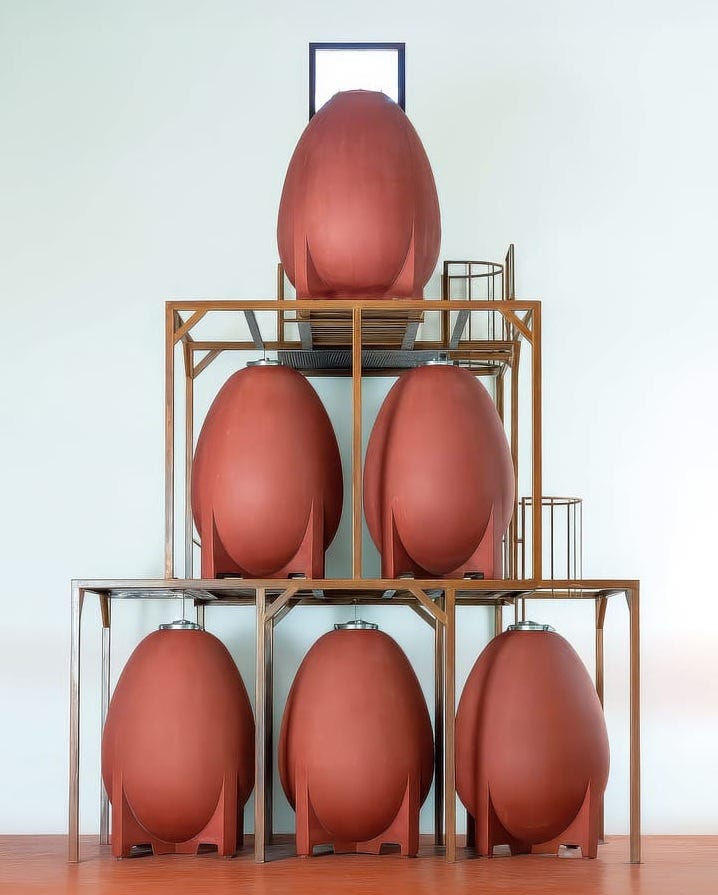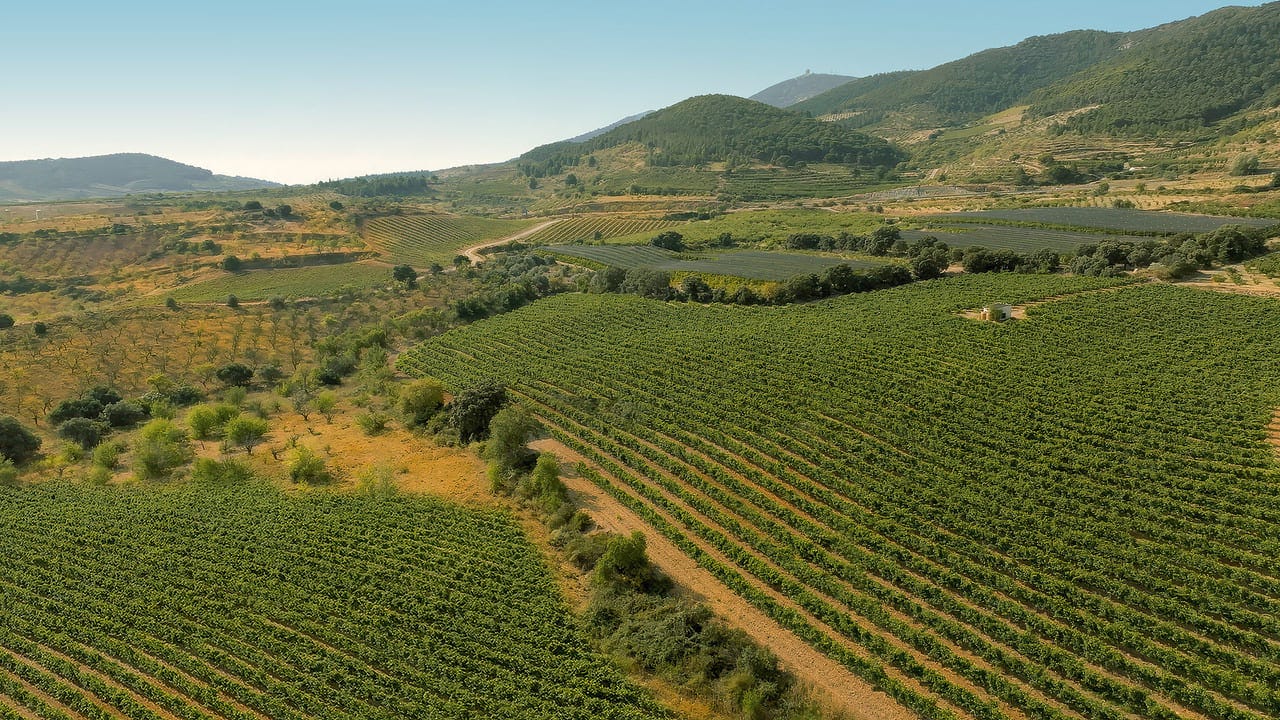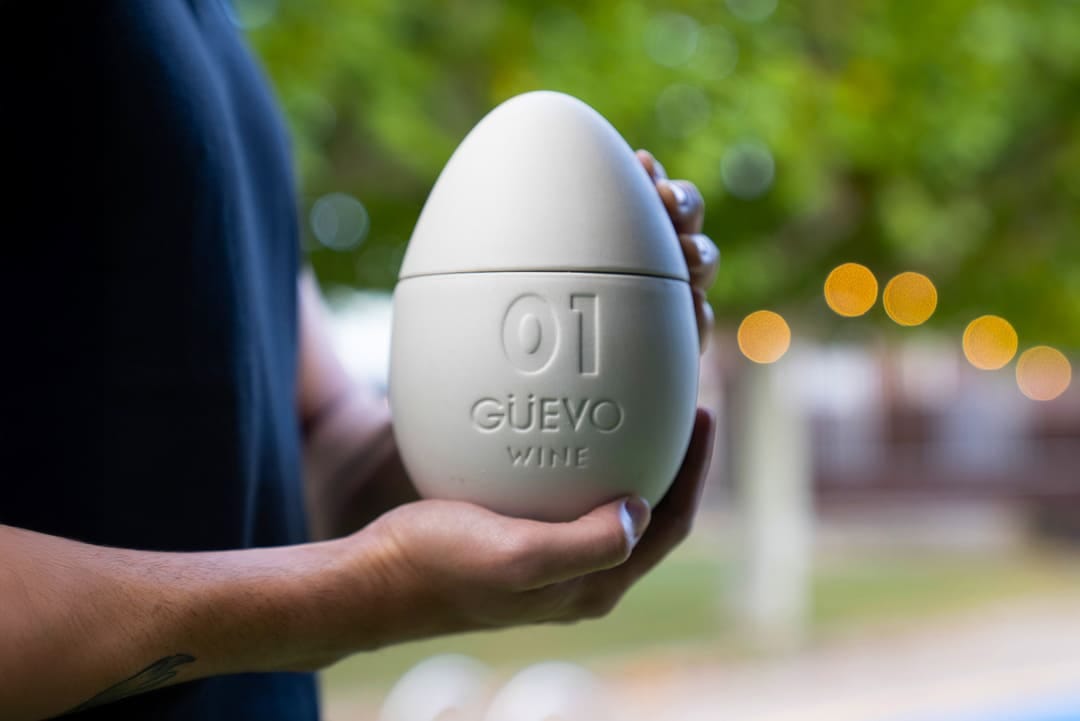In the hills of Spain’s Sistema Ibérico, at 800 meters above sea level, winemaker César Langa has set out to challenge the conventions of modern enology. His project, Güevo Wine, positions itself as a “wine revolution”: a bold blend of ancient amphora wisdom, Sherry-style solera blending, and a futuristic ceramic bottle said to “breathe.” Behind the marketing poetry lies a deeper question for the trade: can such a fusion of past and future truly enhance terroir, stability, and longevity, or is it an example of wine romanticism?
The Ethernum Method
At the core of Güevo’s philosophy lies the Ethernum Method, described as their system combining native grapes, indigenous yeasts, and a criaderas y solera structure, a reference borrowed from Sherry aging traditions. The technique layers multiple vintages in a fractional-blending sequence: each year, a portion of the oldest wine (the solera) is drawn, then replenished by successively younger “criaderas.” The result is an evolving continuum that theoretically ensures consistency, complexity, and maturity.
This concept is hardly unorthodox. The solera system has long been celebrated in Jerez and Madeira for preserving quality and depth over decades, and has become a mainstay of upmarket rum production methods in Latin America. It introduces controlled oxidation and integrates the character of multiple harvests into a seamless whole. Enologists at the University of Cádiz have documented how solera aging maintains stable phenolic balance and promotes long-chain ester formation, which can add complexity and textural richness over time.
What differentiates Güevo’s take is the marriage of solera blending with concrete egg fermentation. In these ovoid vessels, fine lees circulate naturally, creating what the winery calls a “self-bâtonnage.” Studies at UC Davis and INRA Montpellier support the claim that egg-shaped fermenters enhance lees contact and achieve gentle micro-oxygenation. The result is textural roundness and freshness comparable to that of large neutral oak barrels, but without imparting wood aromatics.
Güevo now takes this further by presenting the “world’s first permeable ceramic bottle.”
A Bottle That Breathes
The company’s ceramic vessel is described as both ovoid and porous, mimicking the micro-oxygenation of concrete eggs and ancient amphorae. The idea is that the wine continues to evolve post-bottling, rather than entering stasis as it would in glass.
At first glance, this sounds revolutionary. Controlled oxygen transmission rates (OTR) are well understood in barrel and closure science, yet applying them to the bottle itself is rare. Most ceramic materials have OTR values far higher than glass, raising potential risks of premature oxidation or microbiological instability.
However, laboratory studies published in Food Chemistry (2019) show that fine-grained ceramic composites can be engineered to allow oxygen ingress at rates comparable to natural cork. Enough to maintain slow aging but not spoilage. If Güevo’s material meets that threshold, the concept could hold real technical merit.
Wine-packaging expert Dr. Enrico Chiaranda (University of Padua) notes that “controlled permeability can extend reductive capacity while preventing hydrogen sulfide formation, provided the vessel’s porosity is uniform.” In other words, under ideal design, a breathable ceramic bottle could keep wine evolution stable. Still, large-scale validation is lacking, and peer-reviewed data on Güevo’s bottle have yet to be published.
For sommeliers, the key question is whether such post-bottling evolution is beneficial. In theory, a slow exchange of oxygen may soften tannins or integrate volatile compounds, similar to the subtle development seen in fine wines under natural cork. In practice, without precise calibration, oxidation could outpace maturity.
The Amphora Connection
To understand Güevo’s aesthetic and philosophical drive, we must look back. Amphora winemaking predates barrels by several millennia. Archaeological findings from Georgia’s Kakheti region show qvevri (large clay jars) used for fermentation and storage as early as 6000 BCE. Similar vessels spread through Greece, Italy, and the Roman Empire, where amphorae became both aging and transport containers.
The common denominator: porous clay that allowed gentle micro-oxygenation and thermal stability. In essence, amphorae were the world’s first breathable wine containers. Their egg-like geometry promoted natural convection of lees, the same effect mimicked by modern concrete eggs.
Today’s amphora revival draws from this lineage. Producers from Portugal’s Alentejo to Italy’s Friuli and Oregon’s Willamette Valley now use terracotta vessels for natural or “orange” wines, emphasizing texture, minerality, and purity. According to Decanter (2023), “amphora aging allows the grape’s intrinsic flavor to shine without oak’s aromatic overlay, creating wines of clarity and earth-driven identity.”
Güevo Wine’s Ethernum Method clearly belongs to this lineage, even if it reinterprets it through modern material science. Its “breathing bottle” concept is, in spirit, a continuation of the ancient amphora’s living exchange with its environment.
Terroir & Yeast
Güevo places equal weight on indigenous yeast fermentation, citing both Saccharomyces and non-Saccharomyces strains as contributors to complexity. Research supports this: a 2021 paper in Frontiers in Microbiology found that native yeast consortia increase ester and thiol diversity, leading to more nuanced aromatics.
Yet, wild fermentations also carry unpredictability. Fermentation biologists from the Australian Wine Research Institute warn that spontaneous ferments can result in variable alcohol yields, VA (volatile acidity), or stuck fermentation if poorly managed. Güevo’s use of native yeast thus aligns with the natural-wine ethos but requires disciplined cellar hygiene and monitoring to ensure stability.
In their high-altitude vineyards of El Frasno, the focus on local grape varieties such as Parrel, Almolda, Mazuela (Carignan), and Garnacha further reinforces the authenticity message. Altitude, indigenous microbiota, and low-input farming connect the project to the global trend of “wines that speak the landscape.”
Sustainability & Ethos
Güevo Wine’s environmental positioning is strong: organic and biodynamic viticulture, zero synthetic inputs, low sulfites, no plastics, and local community investment. These align with global movements in regenerative viticulture and carbon-light production. While Güevo offers no third-party certifications, its rhetoric mirrors the sustainability frameworks adopted by producers in Demeter and Ecocert networks.
For restaurants and wine professionals, such commitments are increasingly commercially relevant. Consumers under 40 show higher purchasing preference for “planet-positive” products, particularly when storytelling aligns authenticity with measurable ethics.
Skepticism & Validation
Not all claims can be taken at face value. Güevo cites European Union recognition for innovation, but no official patent or grant reference is provided. Similarly, calling the packaging “the world’s first permeable wine bottle” may be true in a narrow sense, but similar research exists. This includes Vinolok’s oxygen-controlled closures and Amphora Barcelona’s clay bottles used for natural wines.
Still, even if some claims stretch marketing boundaries, the technical ambition is genuine. By attempting to merge solera continuity, amphora-like evolution, and sustainable materials, Güevo sits within a credible movement toward low-intervention, terroir-driven winemaking. Framed through avant-garde design.
A New Wine Story
For sommeliers, restaurateurs, and importers, projects like Güevo represent a new storytelling frontier. They provide:
-
A sensory alternative to oak-dominated profiles: wines defined by purity, texture, and freshness.
-
Sustainability narratives that resonate with environmentally aware diners.
-
Educational value, allowing staff to discuss amphora history, solera blending, and micro-oxygenation in accessible terms.
-
Portfolio differentiation, appealing to adventurous drinkers seeking authenticity without rusticity.
However, these wines must be evaluated on merit, not myth. Sommeliers should monitor bottle evolution and serve the wines with appropriate context, emphasizing that permeability and “living” maturation are deliberate features, not flaws.
The Return Of Living Wines
If the Ethernum Method succeeds technically, it would be a meaningful evolution in how wine connects to its origins. The project’s fusion of amphora physics, solera philosophy, and ecological design speaks to a broader cultural desire. To make wines that breathe, evolve, and express place long after the cork (or ceramic cap) is sealed.
Güevo Wine provides hope that wine innovation does not always mean breaking with the past. Sometimes, progress lies in revisiting forgotten wisdom through modern understanding. A reminder that winemaking still revolves around a single truth, wine as a dialogue between earth, time, and human imagination.
Image Credit: https://www.guevowine.com
_ _ _
© CHURRASCO PHUKET STEAKHOUSE / ALL RIGHTS RESERVED
Reprinting, reposting & sharing allowed, in exchange for a backlink and credits
Churrasco Phuket Steakhouse serves affordable Wagyu and Black Angus steaks and burgers. We are open daily from 12noon to 11pm at Jungceylon Shopping Center in Patong / Phuket.
We are family-friendly and offer free parking and Wi-Fi for guests. See our menus, reserve your table, find our location, and check all guest reviews here:
https://ChurrascoPhuket.com/
#Churrascophuket #jungceylon #phuketsteakhouse #affordablewagyu #wagyu




